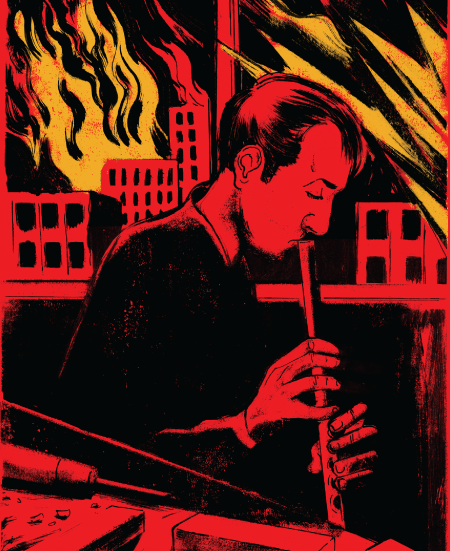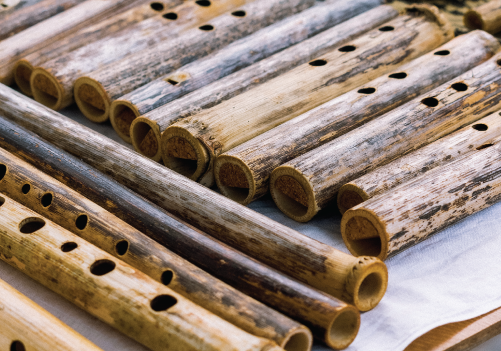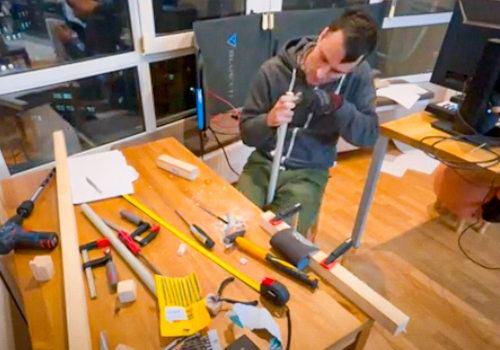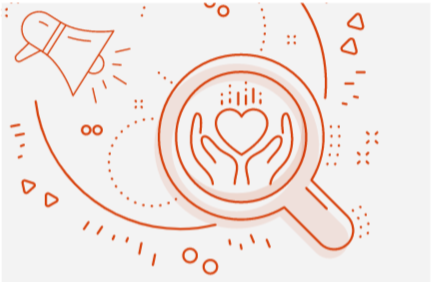An innovative program is bringing a new kind of music education to unexpected places
It’s nighttime in Kyiv, Ukraine, and Mykola Balakin is making a flute-like instrument called a sopilka in his home office. A software engineer by trade and a computer science student online with Oregon State Ecampus, he’s new to making instruments, but after several hours of trial and error, he has a breakthrough.
Utility knife in hand, Balakin carves a hole that should help the traditional Ukrainian woodwind create its distinctive sound. Finally, he presses the sopilka to his lips and plays a tune.
Its notes don’t quite merit a smile, but it’s a special moment, nonetheless.

“I typically would not wake up and say, ‘It’s a day to build a new instrument,’ but that is what I did, and that was the moment I knew it was possible,” Balakin would later recall, proudly. “I like that it works. As an instrument, I do not like it, but as a handmade thing, it’s very nice.”
This was not a personal undertaking. It was his final project in the Music Cultures of the World elective course he recently took online through Ecampus. Balakin’s craftsmanship in Kyiv, 5,600 miles away from Corvallis, is illustrative of Oregon State’s growing impact offering music education at a distance.
And the timing feels right. The new Patricia Valian Reser Center for the Creative Arts, opening this spring, will allow people to engage with art in meaningful ways like never before at OSU. Something similar is happening online, as the university delivers its music expertise through learning experiences that are breaking new ground of their own.
A first-of-its-kind program
When Assistant Professor Dana Reason made her foray into teaching online in 2010, she started big: Her first Ecampus course was a study of the Beatles and their cultural impact. She and her College of Liberal Arts colleagues later developed what was believed to be the world’s first online class on hip-hop music and culture.
That was an era in which OSU — regularly ranked among the nation’s top 10 online education providers — established itself as a trailblazer in online education. Now Reason is the coordinator of the new contemporary music industry bachelor’s program, which is delivered exclusively online. It’s one of the first programs of its kind in the U.S., with a focus on helping students build entrepreneurial skills in the commercial music and entertainment industries.

To watch a time-lapse video of Mykola Balakin making his Ukrainian sopilka, scan this QR code or visit beav.es/T7X.
Reason, an acclaimed composer and pianist, says offerings such as this one — with an emphasis on providing the quality and career-focused skills students are looking for — are driving OSU’s progress on the music education front online.
“We’re no longer trying to replicate the traditional classroom through a lecture-based approach,” she says. “We’re geared towards a diverse collection of online learners and recognize that people learn from games, videos, peer-to-peer discussions, as well as hands-on projects.”
This is achieved in a variety of online courses that emphasize practical learning. Some students might learn to use music production software to create a soundtrack for a film or video game, while others build applied guitar skills and learn to compose through weekly practices and group participation.
A pathway to the music industry
Students who gain those multifaceted skills will be the professionals best prepared for how the music industry operates now and is likely to operate in the future, according to Peter Swendsen, the Patricia Valian Reser chair and director of the School of Visual, Performing and Design Arts.
It’s now standard practice for musicians — from at-home artists to big-name professionals — to collaborate, produce, rehearse and even perform concerts online. Oregon State’s music courses and programs help students acclimate to and succeed in that environment.
He also sees long-term value in how OSU’s online music courses teach not only music history or how to become a better musician, but also about the interactive, everyday experiences people have with sound — from the “beeps and bloops our phones make” to the movies we watch.
“It fills an important gap in higher ed music offerings, and doing it online allows us to reach students around the world.”
“Every bit of music and audio we hear needs a creative force behind it. The whole notion of what it means to be a composer and sound designer has exploded over the last few years,” said Swendsen, also an accomplished musician and composer. “Our courses and the contemporary music industry program will help students go right into that world professionally.”
Swendsen credits Reason and the School of Visual, Performing and Design Arts faculty with designing an online program that is reflective of music that is in the minds and ears of today’s students.
“Dana has done a great job figuring out how to help students learn to treat sound and audio in a conceptual way and how to be comfortable learning new tools on their own,” Swendsen said. “It fills an important gap in higher ed music offerings, and doing it online allows us to reach students around the world that we couldn’t otherwise.”

To watch a time-lapse video of Mykola Balakin making his Ukrainian sopilka, scan this QR code or visit beav.es/T7X.
A Creative Haven
For Balakin in Ukraine, enrolling in Reason’s Music Cultures of the World class both met a degree requirement and offered a therapeutic escape.
He expects to graduate next year, and all around him as he learns online is the destruction caused by the Russian invasion. On the night he completed his sopilka, the power in his apartment building shut off. It’s a common occurrence these days, a result of Russia’s attacks on Ukraine’s energy grid.
His reaction was subdued. He let out a heavy sigh, retrieved a backup generator, then continued making the instrument.
In his war-torn country, Balakin finds refuge online with OSU.
“It’s hard to focus on anything besides reading the news again and again,” he said. “Music helps me with that.”




